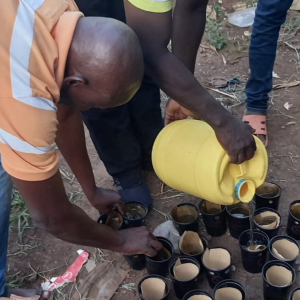Since 2010, HJFMRI has served as the managing partner for the U.S. government-funded, overseas support activities for the U.S. Army Medical Research Directorate – Africa’s (USAMRD-A) Infectious Disease Surveillance Program in Sub-Saharan Africa.
GEIS addresses militarily relevant infectious disease (ID) threats and informs force health protection decision making while contributing to global health through an integrated worldwide emerging infectious disease surveillance system. In support of this program, HJFMRI has implemented surveillance research and outbreak response activities in Uganda, Tanzania, and Kenya and across other Sub-Saharan African nations in collaboration with the Kenya Medical Research Institute (KEMRI), Makerere University–Walter Reed Project (MUWRP), and Stichting PharmAccess International (PAI).
HJFMRI leverages an extensive multi-site surveillance network in each country with clinicians and lab technicians trained on case recruitment and proper specimen handling. The health information provided by these programs are shared with the Ministry of Health (MoH) in each country and other in-country partners to inform medical and public health practice.
Kenya
In Kenya, HJFMRI partners with KEMRI laboratories in Nairobi [AMR, STI and viral hemorrhagic fever (VHF)], Kisumu [acute febrile illness (AFI), malaria drug resistance (MDR), MDC and Entomology] and Kericho (Microbiology Hub) to execute the GEIS program. HJFMRI’s work in Kenya involves 160 staff with expertise in public health, research, lab science, microbiology, and management, who conduct biomedical research and population-based surveillance of emerging IDs and strengthen KEMRI research sites. In Kenya, surveillance sites are located primarily in county and military hospitals in several regions and cover a broad range of Kenyan tribes/cultures and environments.
In the past five years, in addition to sensitizing and training the host country military partners to prepare for potential outbreak response, HJFMRI supported responses to numerous infectious disease outbreaks at the request of the Kenya MoH, the Kenyan Defense Forces (KDF), and the World Health Organization (WHO).
Tanzania
PAI and HJF/HJFMRI have partnered on the implementation of the USAMRD-A GEIS contract in Tanzania since its inception in 2009. Three Tanzania People’s Defence Force (TPDF) medical treatment facilities in Morogoro, Mbeya, and Zanzibar, have been designated as influenza surveillance sites to complement the existing MoH surveillance network. TPDF has a total of eight geographically distributed military hospitals and thirty-six satellite health facilities, some of which are sentinel surveillance sites for this program.
TPDF hospital clients are 80 percent civilian and 20 percent military, representative of the general population and thus making them ideal sentinel sites for influenza surveillance. In addition to protocol development, PAI supports collaborative research programs on emerging infectious diseases and conducts surveillance systems strengthening.
Uganda
The MUWRP–Emerging Infectious Diseases Program (EIDP) is one of MUWRP’s signature programs supported by HJF to build Uganda’s capacity to effectively prevent, detect, and respond to emerging and re-emerging infectious diseases in Uganda.
MUWRP’s surveillance activities span six districts across Uganda and spread into satellite sites in Somalia. Analysis takes place at two MUWRP-owned enhanced biosafety level (BSL)-2 laboratories. Implementation of GEIS activities is done in liaison with the MoH Uganda, the Uganda People’s Defence Force (UPDF), District Health Teams, MoH Somalia, the Somali National Army, and the University of Mogadishu.
